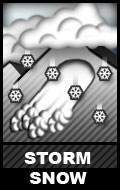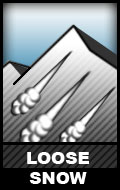Weekend Avalanche Outlook
The avalanche danger in Chugach State Park will be elevated this weekend due to new snow from Thursday night through Saturday morning and strong wind Friday night through Saturday morning. Expect storm slab and loose dry avalanches to be likely in specific areas, and larger persistent slabs to be possible in isolated areas.
At least 3″ at the mid-elevations and 6″+ at the upper elevations of new snow fell Thursday night, accompanied by generally light winds. Heavier snowfall (4″+ at the mid elevations with significantly higher accumulations possible in the upper elevations) and strong SE winds are expected Friday night through Saturday morning.
Avalanche Problems:
Click here to learn more about storm slab avalanches
Touchy D1 to D2 storm slab avalanches are expected to be a possible to likely problem in the upper elevations (3000’+) on leeward (primarily NW) aspects and cross-loaded terrain features like gully sidewalls where the terrain is sufficiently steep (generally >35 degree). Storm slabs may be possible, but are less likely, on other aspects and in deposition areas where an appreciable amount of snowfall from Thursday night to Saturday morning has accumulated.
Red flags like recent avalanches, collapsing (or whumphing), hollow sounding-feeling snow, and cracking will be obvious indicators of the storm slab problem. Pole probing, digging quick handpits, digging a quick snowpit and conducting a stability test like the compression test (CT) or extended column test (ECT), and ski cuts are effective means of assessing and managing the storm slab problem. If you take the time for this sort of basic assessment, the storm slab problem should be relatively easy to identify.
The storm slab danger is expected to peak Saturday morning, and then begin a steady decline.
Click here to learn more about loose dry avalanches
Touchy D1 loose dry avalanches are expected to be a likely problem in the upper elevations (primarily above 3500′) on steep (>40 degree) wind-sheltered terrain. While these sluffs will be relatively small and not inherently dangerous, they will have the potential to catch the unwary off-guard causing a fall or loss of control. In this respect, the terrain will determine the consequences.
Sluffs should be relatively predictable: expect them on steep terrain in sheltered areas with deeper, loose snow. They will be initiated at your feet, and are therefore relatively manageable.
The loose dry avalanche (aka sluff) danger is expected to remain steady in steep, upper elevation, sheltered terrain through the beginning of next week.
Click here to learn more about persistent slab avalanches
Isolated, stubborn persistent slabs up to D2.5 in size are expected to be an unlikely to possible problem primarily on more heavily loaded, leeward (generally NW) upper elevation (3000’+) terrain. These persistent slabs are expected to only be a problem in areas with a sufficiently deep (>2′) and more homogeneous snowpack; this setup providing for a larger slab and underlying weak layer recipe. Persistent slabs are most likely to be initiated from thinner areas and rock outcrops, where this setup does exist.
While the least likely avalanche problem we’ll be dealing with this weekend, it will also be the most inherently dangerous. Persistent slabs will be stubborn, are likely to fracture well above the trigger making escape more difficult, and will be the most difficult to assess; the red flags won’t be as apparent. Digging snowpits, analyzing the layers, and conducting stability tests will be required for a more thorough assessment of the danger in suspect areas. However, if you do see a recent large avalanche that appears to have failed at an interface deeper than that of pre-Thursday snow surface this will be a screaming red flag of persistent slab danger.
The persistent slab danger is expected to peak Saturday morning and then begin a slow but steady decline becoming more stubborn and unreactive but, true to its name, will remain a persistent problem.
Play safe out there and enjoy the new snow!



